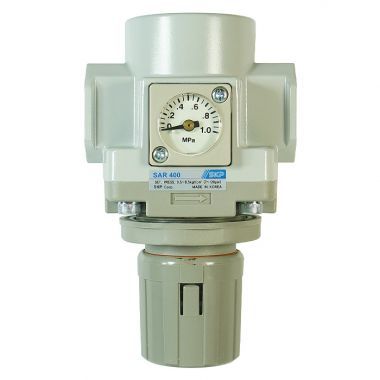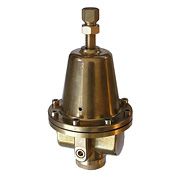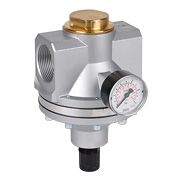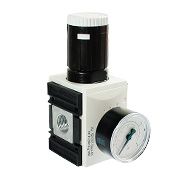Pressure reducer - indispensable in the preparation of compressed air
Compressed air is a medium that has found its application in many fields. It is used, inter alia, to power devices, for the operation of motors and brakes, as a cleaning agent, for industrial installations, as well as in anesthetic equipment and in respirators. Most air preparation units operate in a similar manner using filters, a pneumatic regulator, and a lubricator.
Compressed air filtration consists in removing mainly solid particles from it. Filter cartridges have a specific cleaning accuracy - 40 μm has been adopted as a standard, which corresponds to the fifth purity class. It is sufficient for the correct operation of the pneumatic fittings. In the case of more precise elements, the filtration accuracy should be higher and, according to ISO 8573-1: 2010, it should have air purity class 3. Filters also remove water and larger oil particles. Usually, when selecting a filter for pneumatic applications, it is necessary to check the relevant standards for a given system.
The next stage of compressed air preparation is de-oiling. The maximum oil concentration in milligrams per cubic meter is also specified in ISO 8573-1. The finest filtration, 0.01 mg / m3, is primarily required in food-related or pharmaceutical applications. Such precise filters can also be intended for very precise devices using pneumatic systems.
Then the air must be dried, ie free from water molecules. As for industrial use, air humidity should not exceed 21%. Water is not only responsible for corrosion, but can also cause malfunctions, especially in pneumatic systems.
The air pressure reducer is another element of the air preparation unit. Its task is to maintain a constant pressure in the pneumatic system. Finally, the oil mist should be delivered to the operating medium, which is designed to extend the operation of the entire system and prevent excessive abrasion of its individual components.
Air pressure regulators
Pressure regulators are devices that are one of the elements of compressed air preparation systems. They are intended to reduce the higher inlet pressure to the required lower level by the devices connected to the outlet port. The pressure reducing valve is self-adjusting thanks to the differential pressure. Regardless of the variation in downstream pressure, the downstream pressure remains constant.
Reducers are not complicated in their construction, they can also be integrated with other elements aimed at increasing their functionality or improving safety. Then it is very important that all parts of the team work together perfectly and are of the best quality. That is why it is so important to bet only on proven products.
Even if the construction of individual reducers is different, the principle of their operation remains the same. By means of a pusher and a spring, the air moves the plug in the direction depending on the existing pressure. If the pressure cannot neutralize the spring force, the poppet is pushed downwards. If it reaches the desired value, the mushroom will close the air flow. The output pressure is lowered through an opening in the diaphragm. By reducing the spring pressure, the pressure in the tank and under the diaphragm raises it, and compressed air goes to the atmosphere. In the event that a given air regulator does not have a pressure relief, the holes in the plug and the pusher apply the pressure consistent with that located under the diaphragm. In this way, the effect of the inlet pressure on the set outlet pressure is limited. Filter reducers can also be used for this, which combine the reducer with the filter, while having smaller dimensions.
Which air pressure reducer to choose? The most important parameters
Choosing the best air pressure reducer should not be complicated if it is made based on a few basic parameters. You will need to specify the type and size of the threaded connection and the operating pressure range, as well as the flow and regulation characteristics. To determine the pressure at the reducer outlet, the maximum operating pressure of the actuator and the pressure drop between the reducer and the pneumatic drive chamber should be taken into account.
The most frequently chosen pressure reducers are those with an inlet pressure of 40 bar, because it works very well in home and workshop conditions. Less common are large regulators, for example with a pressure of 200 or 300 bar, which additionally have a specific design. The most precise reducers are 1 bar and lower, thanks to which the output pressure can be controlled very precisely.
In the case of connections, 1 "pressure reducers and ½" pressure reducers are the most common. In addition to the diameter of the connection itself, it is also worth paying attention to the position in which the regulator can be mounted. Those mounted in any position can be easily obtained today, but there are still models that need to be mounted in one specific position.
If you want to buy an air pressure reducer for a paint spray gun or other precise devices, it is worth choosing a model with a filter. In this way, it will be easy to get rid of impurities, and the reducer itself will be better protected. If, on the other hand, the pressure regulator is to be used in a device in which it is necessary to monitor the operating pressure on an ongoing basis, then a pressure gauge will be required. Most of the regulator models have an integrated pressure gauge, however in the case of industrial and installation regulators it may be necessary to connect an external pressure gauge.
It is also worth paying attention to the capacity of a given air pressure reducer. It should be adapted to the needs of the end device. The change in throughput may be mainly due to the change in connection diameter. However, it can also occur between models of the same diameter, which is why it is so important to take this criterion into account as well.
Another is the output pressure adjustment range on the air pressure reducer. Specifies with what accuracy and with what offset the pressure can be changed. In many cases, this is a really important parameter and should be taken into account when making your choice.
Depending on their purpose, pressure regulators can be used in many different conditions, also when it comes to temperature. Then it is worth taking a closer look at the temperature range in which the reductant mechanisms will work properly. Usually this is between -10 ° C and + 60 ° C, which should be sufficient for most applications. In special cases, when this range will not be optimal, you should look for specialized reducers that are designed to operate at even lower or even higher temperatures.





Login and Registration Form